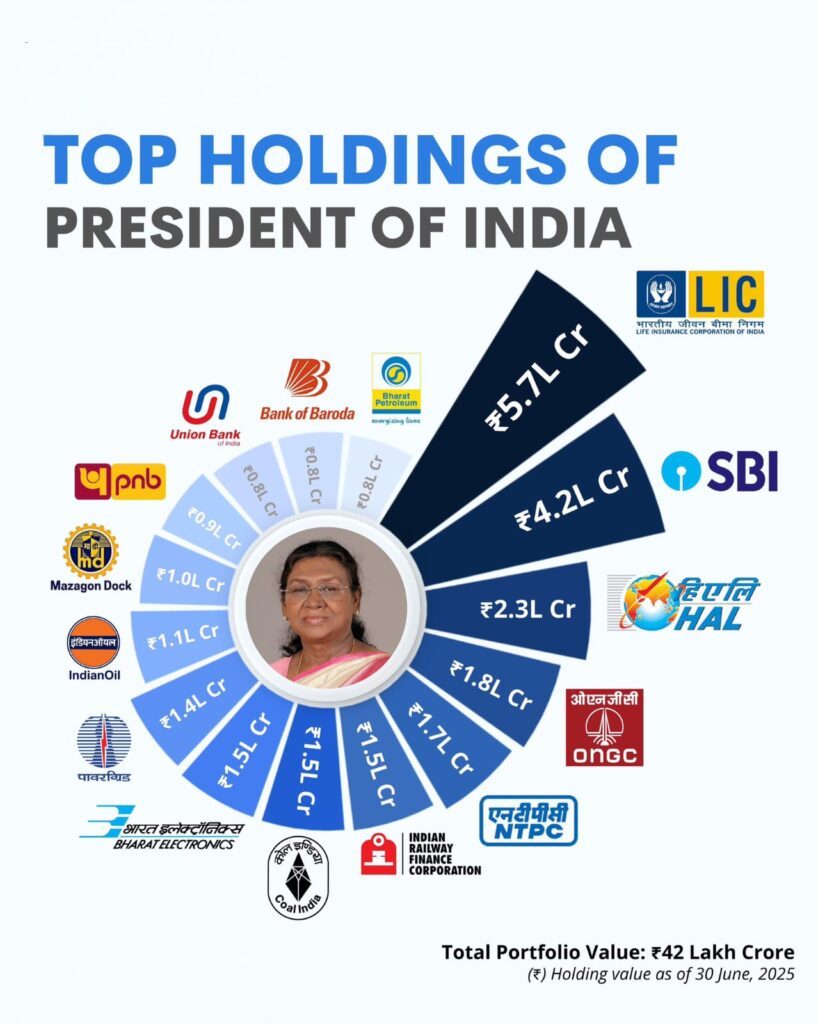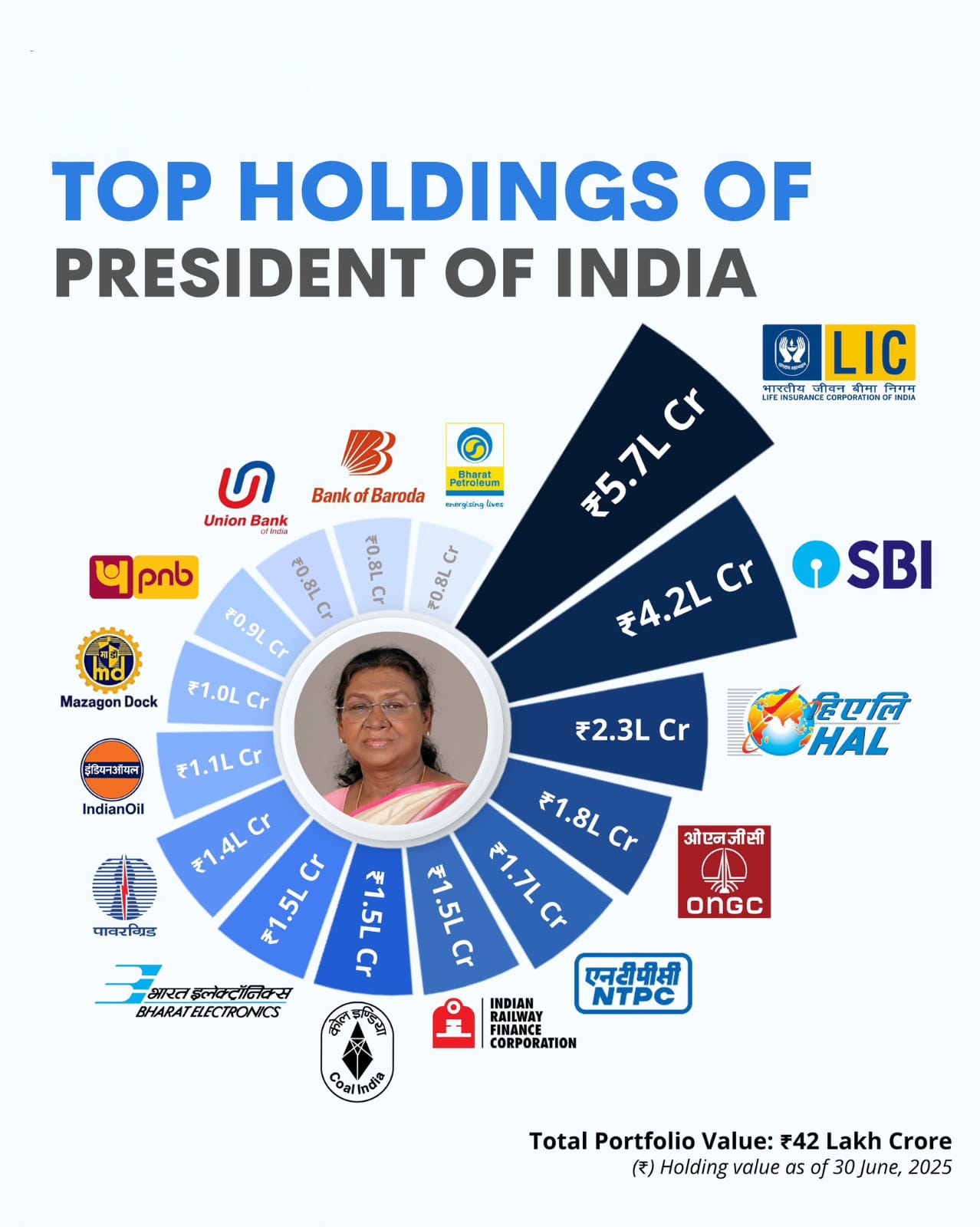How the President of India is listed holding 78 public company stocks worth over ₹42 lakh crore as of June 2025. Learn top holdings, trends and what it means for investors.
President of India Stock Holdings: 78 Stocks Worth ₹42 Lakh Crore Revealed
A recent InvestyWise post says the President of India publicly holds 78 stocks, valued at over ₹42 lakh crore as per June 2025 filings. That’s massive! But what does this really mean? Let’s break it down in easy everyday language:
What Does This Holding Actually Mean?
When they say the President of India holds these shares, it doesn’t mean the head of state personally picked or owns them. Rather, these are government holdings in public sector companies, reported under the President’s name on exchanges.

This is standard: the President is a legal figure for reporting, but decisions are by ministries and government boards.
How Big Is ₹42 Lakh Crore?
To give perspective:
In June 2025, the total public sector holding value under the President’s name crossed ₹42 lakh crore.
That’s equivalent to more than US$5 trillion, making it one of the largest custodial portfolios in the world.
Pretty astonishing for a public disclosure!
Top Shares in the Portfolio
Here are some key holdings (as of the latest Q ended Jun 2025):
- Bank of Baroda – ~₹80,144 crore (~64% owned)
- Bharat Electronics – ~₹1,45,125 crore (~51%)
- Indian Oil, NTPC, Coal India, Power Grid – all over ₹1 lakh crore each
- Life Insurance Corp (LIC) tops at ~₹5,48,746 crore (~96.5%)
The portfolio is heavily concentrated in public sector banks, energy, mining, insurance and utilities.
Also Read – Nikhil Kamath’s WTFund.
Why Should You Care?
Transparency Corner
Listing these holdings publicly means the Indian government is sharing how much it holds in public companies. That boosts transparency and trust.
Investor Insight
These are large‑cap PSUs — their performance often reflects government policies, crude trends, interest rates and infrastructure plans. So knowing these holdings gives insight into the big picture of public sector strength.
No Personal Wealth
Remember: this does not reflect the personal wealth of the President. It’s state ownership, used for reporting via corporate filings.
FAQs: President of India stock holdings
Q1. Does the President really buy these shares?
Answer: No. These are held by the Government of India. Reporting is through the President of India as per regulatory norms.
Q2. Where does ₹42 lakh crore figure come from?
Answer: It comes from shareholding data filed with stock exchanges (latest quarter June 2025) listing 78 stocks totaling that value.
Q3. Which public companies feature in the list?
Answer: Major names like LIC, Bank of Baroda, Indian Oil, NTPC, Coal India, Bharat Electronics, plus many heavy‑weight PSUs in energy, finance and utilities.
Q4. Is this an estimate or confirmed official data?
Answer: It’s official—corporate shareholding disclosures by each listed company, compiled by platforms like Trendlyne.
Q5. Why does the President appear on the filings?
Answer: SEC regulations require reporting the ultimate owner—so central government holdings appear under the President of India title.
What Investors Should Learn?
Analytical View
As an equity investor, consider this:
Large PSU holdings show where government trust lies.
If you’re analysing PSU stocks, this gives a benchmark: how much stake remains with govt vs public.
But Don’t Overthink
These figures don’t affect stock prices directly divests or changes policy.
These holdings aren’t personal picks—they’re strategic, long‑term stakes.
TL;DR Snapshot
| Topic | Summary |
| Why does the President appear? | Legal reporting format for Govt holdings |
| How many stocks? | 78 public sector stocks |
| Combined value? | Over ₹42 lakh crore as of June 2025 |
| Top sectors | Banking, Insurance, Utilities, Energy, Mining |
| Key holdings | LIC (~₹5.5L Cr), Bank of Baroda, NTPC, Coal India, Power Grid |
Final Thoughts: President of India stock holdings
To wrap up—it’s eye-opening to see government stake reported under the President, in ultra-high rupee terms. While this doesn’t mean personal wealth, it does reflect the value and scale of public sector assets.
For common investors, it’s a window into where government money resides, which firms remain primarily government-owned, and where divestment could happen in future.


[…] Also Read – President Of India Stock Holding. […]